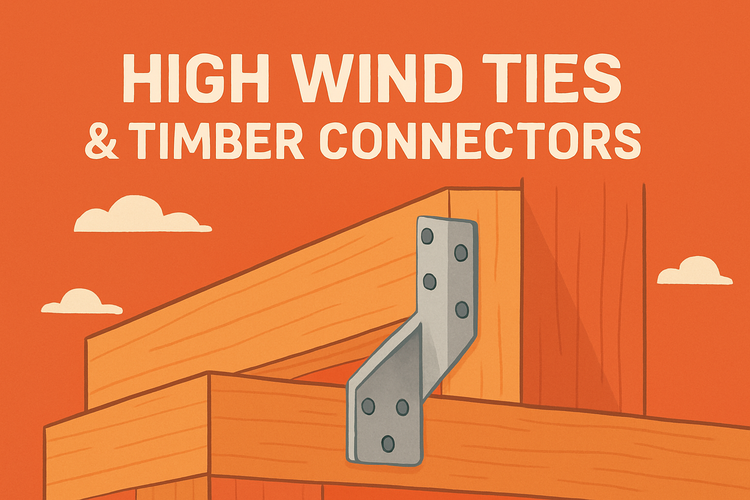Complete Guide To High Wind Ties & Timber Connectors For Builders

Understanding the Role of High Wind Ties in Structural Integrity
High wind ties are essential components in building construction, particularly in areas prone to hurricanes and strong gusts. They secure critical joins in a timber structure, helping to prevent wind uplift and racking.
These connectors are specifically designed to transfer lateral and uplift loads from the roof and upper building levels down to the foundation. Installed at key pressure points like truss-to-wall connections or rafter-to-wall interfaces, they provide an effective load path that resists structural separation. The number and type of ties used in a build often depend on wind load ratings, and selecting the correct hardware plays a major role in ensuring compliance with building codes.
Incorporating high wind ties complements other structural reinforcements and can significantly increase a building's lifespan, especially under harsh weather. Paired with durable roof connectors, they allow for a secure, code-compliant system that holds up in even the toughest conditions. Builders are strongly advised to include these components early in the design phase to avoid costly retrofits later.
Types of Timber Connectors for Wind Protection
Not all timber connectors serve the same purpose; several are specifically engineered for use in high wind zones. Understanding the distinctions can help builders stay both safe and efficient.
Hold-downs, hurricane clips, and twist straps are among the most common products in the high wind ties category. These elements are designed to create continuous load paths from the top of the structure to the foundation, resisting forces that would otherwise pull materials apart. Modern high wind connectors are typically made from galvanized steel to endure both mechanical stress and environmental exposure.
For example, post base anchors allow for solid foundation reinforcements by securely connecting vertical posts to concrete surfaces. Likewise, metal twist straps are used to anchor rafters and joists deeply into structural framing. These solutions are essential in ensuring the resilience of timber structures subjected to varied wind pressures.
Choosing the right combination of connectors helps distribute wind-induced stress uniformly across the entire frame. Reviewing products listed under high wind ties & timber connectors ensures you’re sourcing from a collection that covers wide load requirements and installation types.
Installation Best Practices for Wind-Resistant Frames
Proper installation of high wind connectors is as important as selecting the right type. A poorly installed tie provides minimal protection, leading to potential structural weaknesses.
Always begin by identifying load points and ensuring alignment with wind load calculations. Use corrosion-resistant fasteners and follow manufacturer guidelines for spacing and placement. Many connectors come with pre-drilled holes to assist in accurate installations. Proper embedment in framing members ensures connectors perform as intended when loads are applied.
The use of high-quality fasteners from the screws and nails category is essential for safety and compliance. Fasteners must match the material specification of each tie to prevent galvanic corrosion or mechanical failure. Field conditions should always be considered, and connectors should be periodically inspected after installation for signs of fatigue, water intrusion, or dislocation.
Pairing High Wind Ties with Timber Frame Components
Timber framing systems benefit significantly from the inclusion of high wind ties. These metal connectors integrate seamlessly into the framework and drastically enhance resistance to shear and uplift.
One effective strategy is reinforcing key timber joints using specialized timber frame connectors in combination with wind ties. The two categories complement each other by providing both joint integrity and wind resistance. This dual approach ensures that structural loads are efficiently distributed and transferred through the timber shell to the foundation.
During storms, uplift pressure behaves unpredictably, stressing weak joints without reinforcement. Connection points such as top plates, end joists, and rafter-to-wall joins are areas especially vulnerable. Strategically applying connectors at these points with high wind anchorages ensures consistency in performance.
Long-Term Durability and Maintenance Considerations
Beyond installation, the long-term performance of high wind ties depends on routine maintenance and inspections. Environmental exposure and natural aging can reduce their effectiveness over time, particularly in coastal or humid climates.
Use galvanized or stainless steel options for maximum resistance to rust and corrosion. If the structure is located near saltwater environments, consider using marine-grade solutions to prevent rapid decay. Regular checks should include signs of rust, loose fasteners, warping, or compromised attachment to timber.
Ensuring that structural protection remains intact helps avoid costly damage and repairs post-storm. It’s also important to factor in compatibility with building materials and fastener types from collections like joist hangers to guarantee uniform installation quality. Periodic reinforcement or replacement of aging components supports the longevity and safety of the entire system.
